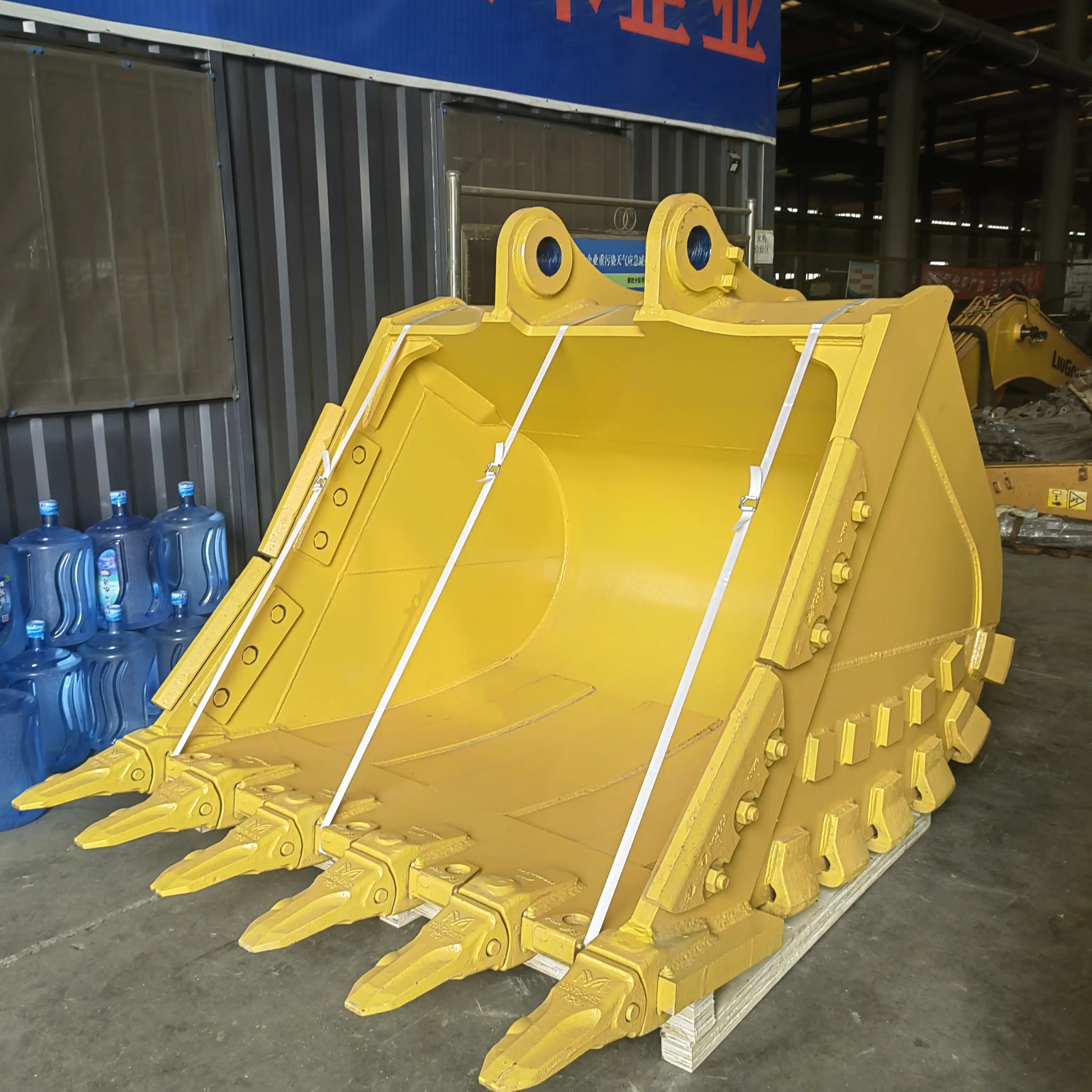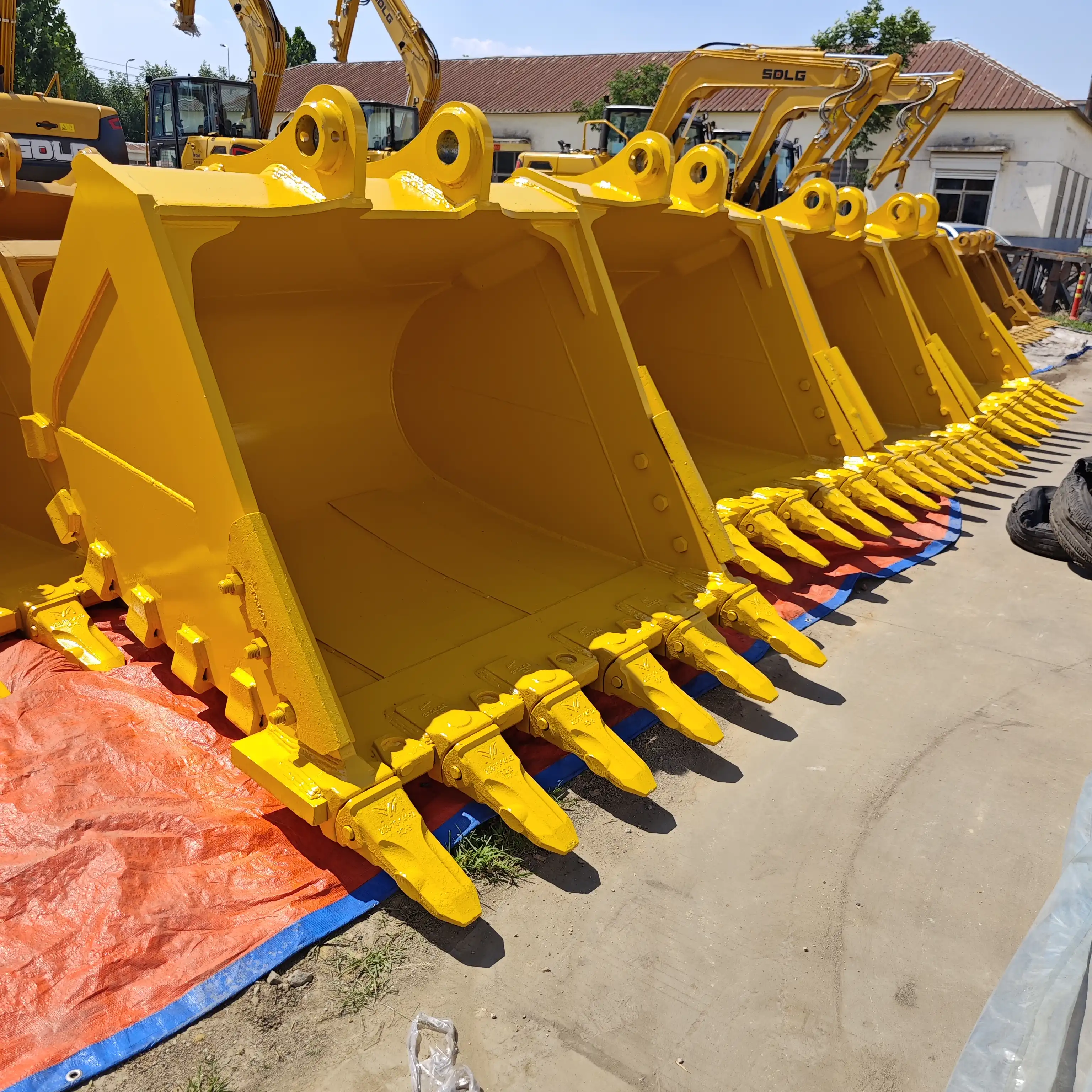What is the bucket capacity of 30 ton excavator?
For a 30-ton excavator, the standard excavator bucket capacity typically ranges from 1.4 to 1.8 cubic meters (approximately 1.8 to 2.4 cubic yards). This capacity is optimal for balancing excavation efficiency with the machine's hydraulic capabilities and structural limitations. The bucket size directly impacts productivity, fuel consumption, and overall operational costs. When selecting a bucket for a 30-ton machine, operators must consider specific job requirements, material density, and terrain conditions. Heavy-duty applications like rock excavation may require smaller, reinforced buckets, while lighter materials allow for larger capacities. Many contractors opt for multiple bucket sizes to maintain versatility across different projects. Manufacturers like Tiannuo Machinery offer customizable bucket solutions ranging from 0.1 to 5.0 cubic meters to meet specific operational needs, ensuring 30-ton excavator owners can optimize their equipment performance for various tasks.
1.4 to 1.8 Cubic Meters

Materials Matter
The material composition of an excavator bucket significantly influences its performance and durability. For 30-ton excavators, buckets are typically manufactured using high-strength wear-resistant steel, such as AR400 or Hardox 450. These materials provide exceptional resistance against abrasion and impact, crucial for handling challenging materials like rock, concrete, or compacted soil. The sidewalls and cutting edges often incorporate additional hardened steel overlays or plates to extend service life in high-wear areas.
The quality of steel used directly impacts bucket longevity – premium buckets utilize steel with carbon content between 0.28% and 0.33%, offering optimal hardness without compromising structural integrity. Tiannuo Machinery's buckets implement specialized manufacturing techniques including precision cutting, multi-stage welding processes, and heat treatment, to ensure consistent quality.
Structural Considerations
The structural design of a 30-ton excavator bucket involves complex engineering to balance strength, weight, and excavation efficiency. Key design elements include:
①Reinforced heel plates that distribute stress during digging operations
②Optimized bucket profile for improved penetration and material flow
③Strategically placed wear strips along high-friction areas
④Tapered sidewalls that reduce material sticking
⑤Properly angled cutting edges that maximize digging force
A well-designed bucket maintains structural integrity through thousands of load cycles. The stress distribution patterns must account for various loading scenarios encountered during operation. The connection points between the bucket and excavator arm receive special reinforcement, as these areas experience the highest mechanical stress during operation.
Performance Optimization
Modern 30-ton excavator buckets incorporate design features that optimize performance beyond basic functionality. These include:
①Curved floor profiles that improve material retention and discharge
②Integrated spill guards that prevent material loss during lifting operations
③Recessed bolt heads that minimize wear and snagging
④Balanced weight distribution for improved hydraulic efficiency
⑤Streamlined interior surfaces that reduce material buildup
These design elements work together to maximize the bucket's capacity utilization while minimizing cycle times. The difference between a standard and performance-optimized bucket can result in productivity gains of 8-12% over extended operation periods, translating to significant cost savings for contractors and operators.
Model Variations

General Purpose Buckets
General purpose buckets represent the most common configuration for 30-ton excavators, offering balanced performance across various applications. These buckets typically feature flat bottoms with moderate curvature, standard teeth arrangements, and side cutters for versatility. Their 1.4-1.8 cubic meter capacity makes them ideal for everyday excavation tasks including:
①Trench digging for utilities or foundations
②General earth moving and grading
③Loading trucks with loose materials
④Site preparation and cleanup
The tooth pattern on general purpose buckets usually consists of 5-7 evenly spaced teeth that provide adequate penetration for most soil conditions without excessive wear. Side cutters help maintain clean trench walls and provide additional protection for the bucket sides. Many operators prefer these buckets as their primary attachment due to their adaptability across job sites.
While not specialized for extreme conditions, quality general-purpose excavator buckets incorporate wear-resistant materials at key contact points. Their balanced design prioritizes material handling efficiency while maintaining reasonable wear characteristics and fuel economy. When equipped with a quick-coupler system, these buckets allow operators to rapidly switch between attachments as job requirements change.
Heavy-Duty and Rock Buckets
For demanding applications involving rock, concrete, or highly compacted materials, heavy-duty and rock buckets offer enhanced durability with modified capacities. These specialized buckets for 30-ton excavators typically feature:
①Reduced capacity (often 1.2-1.5 cubic meters) to accommodate thicker steel construction
②Reinforced cutting edges with heavy-duty teeth configurations
③Additional wear plates in high-impact areas
④Structural reinforcements at stress points
⑤Modified geometry for improved penetration force
The tooth configuration often includes fewer but larger teeth with specialized profiles designed specifically for rock penetration. These teeth may incorporate replaceable wear caps or tips to extend service life in extreme conditions. Internal gussets and reinforcement ribs distribute impact forces throughout the bucket structure, preventing deformation during high-stress operations.
While sacrificing some capacity compared to general-purpose options, these specialized excavator buckets dramatically extend service life in harsh environments. The initial investment in a heavy-duty bucket typically pays for itself through reduced downtime and maintenance costs when working in demanding conditions.
Specialized Application Buckets
Beyond standard configurations, 30-ton excavators can utilize specialized buckets designed for specific tasks:
①Ditching buckets with wider, flat bottoms for finishing work (1.6-2.0 cubic meters)
②Skeleton buckets for material separation and screening (1.4-1.7 cubic meters)
③V-shaped buckets for precision drainage work (1.3-1.6 cubic meters)
④Grading buckets with straight cutting edges for fine leveling (1.5-1.9 cubic meters)
These specialized designs modify the standard capacity to accommodate their unique functional requirements. For instance, ditching buckets typically offer slightly larger capacities due to their wider, shallower design, while skeleton buckets may have comparable volume but significantly less weight due to their open construction.
The specialized nature of these buckets makes them invaluable for contractors focusing on specific applications. While they may not be as versatile as general-purpose options, their efficiency gains in targeted applications can dramatically improve project timelines and quality outcomes.
Factors Affecting Bucket Capacity
Material Density Considerations
The optimal bucket capacity for a 30-ton excavator varies significantly based on material density. While the standard 1.4-1.8 cubic meter capacity works well for average soil conditions, operators must adjust expectations when working with materials of varying weights:
①Light materials (dry soil, mulch): Can utilize full bucket capacity
②Medium-density materials (mixed earth, clay): May require 85-95% fill rates
③High-density materials (wet clay, gravel): Often limited to 70-80% capacity
④Extremely dense materials (rock, concrete): May restrict to 50-65% capacity
Excavator bucket selection should account for these density factors – attempting to move full buckets of high-density materials can strain hydraulic systems, reduce boom stability, and accelerate wear on pivot points. The equipment's lifting capacity charts typically specify maximum weights at various arm positions, which helps operators determine appropriate fill levels.
Professional operators develop an instinctive feel for appropriate bucket loading based on material characteristics, allowing them to maximize productivity while minimizing machine stress. Modern excavators sometimes incorporate load-sensing systems that warn operators when approaching maximum capacity thresholds.
Operating Environment Impact
Environmental conditions significantly influence effective bucket capacity utilization:
①Temperature extremes affect hydraulic system performance
②High-altitude operations reduce engine power output
③Underwater excavation creates additional resistance
④Confined spaces limit swing radius and bucket positioning
⑤Sloped terrain affects stability and digging angles
These factors can reduce the practical capacity by 10-30% compared to ideal conditions. Experienced operators adjust their excavation strategies accordingly, often opting for partial bucket loads to maintain cycle speed efficiency rather than struggling with maximum volume.
For specialized environments, modified excavator buckets may incorporate features like drainage holes for underwater work, reinforced edges for rocky conditions, or narrower profiles for confined spaces. These adaptations help maintain operational efficiency despite challenging conditions.
Attachment Compatibility
The interaction between bucket capacity and attachment systems affects overall performance:
①Direct pin mounting allows maximum bucket capacity utilization
②Quick coupler systems typically reduce effective capacity by 3-8%
③Tilt rotator attachments may further reduce capacity by 5-12%
④Specialized attachments like thumbs or grapples affect weight distribution
While these attachment systems provide valuable versatility, operators must understand their impact on effective bucket capacity. The weight of the attachment system itself reduces the available payload capacity, requiring adjustments to bucket size selection or fill levels.
Modern excavator bucket designs increasingly incorporate compatibility features that minimize these capacity penalties. Purpose-built integration between buckets and attachment systems can recover much of this lost efficiency through optimized geometry and weight distribution.
FAQ
①What factors determine the ideal bucket size for a 30-ton excavator?
The ideal bucket size depends on material density, application requirements, and site conditions. While 1.4-1.8 cubic meters is standard, factors like rock content, excavation depth, and cycle time requirements may warrant adjustments. Consider your specific operational needs and material types when selecting an excavator bucket.
②How does bucket capacity affect excavator performance?
Bucket capacity directly impacts productivity, fuel efficiency, and machine wear. Oversized buckets strain hydraulic systems and increase cycle times, while undersized buckets reduce efficiency. The optimal capacity balances maximum material moved per cycle without compromising machine performance or stability.
③Can I use a larger bucket on my 30-ton excavator?
While technically possible, using oversized buckets (beyond 1.8-2.0 cubic meters) on 30-ton excavators can cause accelerated wear, hydraulic system stress, and stability issues. Always consult your machine's specifications before exceeding recommended capacity ranges.
④How often should excavator buckets be replaced?
Replacement intervals vary based on application severity, material abrasiveness, and maintenance practices. With proper care, premium excavator buckets can last 3,000-5,000 operating hours in moderate conditions, while severe applications may require replacement after 1,500-2,500 hours.
Excavator Bucket Manufacturers
The standard bucket capacity for 30-ton excavators ranges from 1.4 to 1.8 cubic meters, striking an optimal balance between productivity and machine capability. This capacity range accommodates most general excavation tasks while maintaining reasonable cycle times and fuel efficiency. However, understanding that operational requirements vary significantly across projects, many contractors maintain multiple bucket options to maximize versatility.
Selecting the appropriate bucket for excavator involves careful consideration of material density, terrain conditions, and specific application requirements. Premium buckets manufactured with high-quality materials and precise engineering provide superior durability and performance, ultimately delivering better value despite higher initial investment. With proper selection, maintenance, and operation, these attachments significantly impact overall project efficiency and equipment longevity.
For specialized applications or custom bucket requirements for your 30-ton excavator, contact reputable bucket manufacturers who can provide tailored solutions. Tiannuo Machinery, as a leading excavator bucket manufacturer, offers comprehensive consultation and customization services to ensure you receive the optimal bucket configuration for your specific operational needs. Our engineering team specializes in designing buckets that meet exacting specifications while balancing cost-effectiveness and performance. For more information about our custom bucket solutions, contact us at tn@stnd-machinery.com.
References
Smith, J. (2023). Heavy Equipment Attachments: Selection and Application Guide. Construction Engineering Journal, 42(3), 78-92.
Thompson, R. & Williams, K. (2024). Excavator Performance Optimization: Attachment Selection for Maximum Productivity. International Journal of Construction Machinery, 18(2), 112-127.
Chen, H. (2023). Material Properties and Their Impact on Excavation Equipment Selection. Journal of Construction Materials, 29(4), 341-356.
Anderson, M. et al. (2024). Comparative Analysis of Excavator Bucket Designs for Various Applications. Engineering Equipment Review, 15(3), 203-218.
Roberts, P. (2023). Maintenance Strategies for Extended Equipment Lifespan in Construction Applications. Heavy Machinery Maintenance Quarterly, 37(1), 45-61.
About Author: Arm
Arm is a leading expert in the field of specialized construction and railway maintenance equipment, working at Tiannuo Company.

